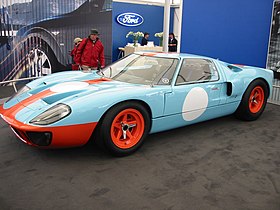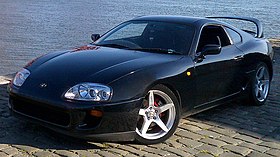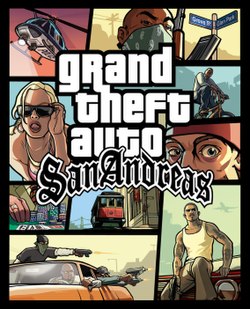This article is about the 1960s Ford GT racing car. For the 2004-2006 supercar based on it, see Ford GT. For the 2013 supercar, see Galpin Ford GTR1. For the graphic computer terminal produced by Digital Equipment Corporation, see DEC GT40. For other uses, see Ford GT (disambiguation).
| Ford GT40 | |
|---|---|
 | |
| Overview | |
| Manufacturer | Ford Advanced Vehicles John Wyer Automotive Engineering Kar Kraft Shelby American |
| Production |
1964-1969[1]
107 produced |
| Assembly | Slough, UK (Mk I, Mk II, and Mk III) Detroit, Michigan, USA (Mk IV) |
| Body and chassis | |
| Class | Group 4 Sports Car Group 6 Sports Prototype |
| Body style | Coupe Roadster |
| Powertrain | |
| Engine | 4181 cc (255 CID) V-8 4737 cc (289 CID) V-8 6997 cc (427 CID) V-8 4942 cc (302 CID) V-8 |
| Transmission | 4-speed manual |
| Dimensions | |
| Wheelbase | 95 in (2,413 mm)[2] |
| Length | 160 in (4,064 mm) |
| Width | 70 in (1,778 mm) |
| Height | 40.5 in (1,029 mm) |
| Curb weight | 2,002 lb (908 kg) |
| Chronology | |
| Successor | Ford P68 and Ford GT |
The Ford GT40 is a high performance American-British racing car, built and designed in England (Mk I, Mk II, and Mk III) and in the United States (Mk IV) respectively, and powered by a series of American-built engines, which won the 24 Hours of Le Mans four consecutive times, from 1966 to 1969 (1966 being the Mk II, 1967 the Mk IV, and 1968-1969 the oldest chassis design, the Mk I). In 1966, at the attendance of Henry Ford II himself in Le Mans, the Mk II GT40 provided Ford with the first overall Le Mans victory for an American manufacturer [3][4] and the first victory for an American manufacturer at a major European race since Jimmy Murphy´s triumph with Duesenberg at the 1921 French Grand Prix. The Mk IV GT40, which won the race in 1967, remains, to this day, the only car designed and built entirely in the United States to claim an overall win at Le Mans.[5]
In addition to four consecutive overall Le Mans victories, Ford also won the following four FIA international titles (at what was then unofficially known as the World Sportscar Championship) with the GT40:
- 1966 International Manufacturers Championship - Over 2000cc
- 1966 International Championship for Sports Cars - Division III (Over 2000cc)
- 1967 International Championship for Sports Cars - Division III (Over 2000cc)
- 1968 International Championship for Makes
The GT40 was originally produced to win long-distance sports car races against Ferrari (who won at Le Mans six times in a row from 1960 to 1965). Chassis # P-1075, which won in 1968 and 1969, is the first car in Le Mans history to win the race more than once with the same chassis, using a Ford engine originally of 4.7-litre displacement capacity, enlarged to 4.9-litre (also known as a 5.0) with special alloy Gurney-Weslake cylinder head.
The car was named the GT (for Grand Touring) with the 40 representing its overall height of 40 inches (1.02 m, measured at the windshield) as required by the rules. Large displacement Ford V8 engines (4.2 litre, 4.7 litre and 7 litre) were used, compared with the Ferrari V12 which displaced 3.0 litres or 4.0 litres.
Early cars were simply named "Ford GT". The name "GT40" was the name of Ford's project to prepare the cars for the international endurance racing circuit, and the quest to win the 24 Hours of Le Mans. The first 12 "prototype" vehicles carried serial numbers GT-101 through GT-112. The "production" began and the subsequent cars, the MkI, MkII, and MkIIIs, (with the exception of the MkIV, which were numbered J1-J10) were numbered GT40P/1000 through GT40P/1145, were officially "GT40s". The name of Ford's project, and the serial numbers dispel the story that "GT40" was "only a nickname."
The contemporary Ford GT is a modern homage to the GT40.








